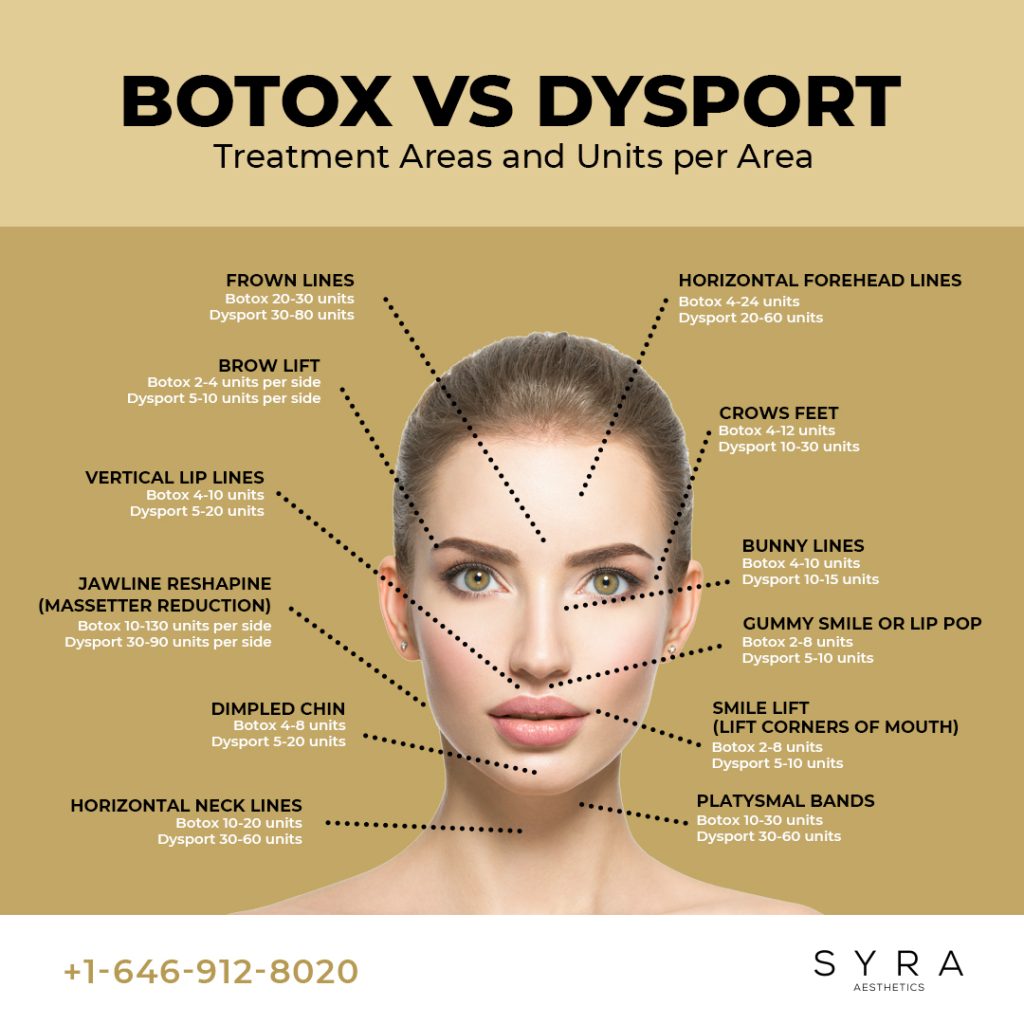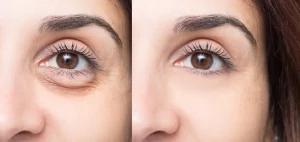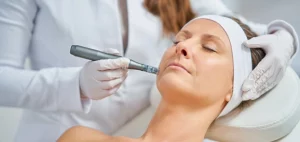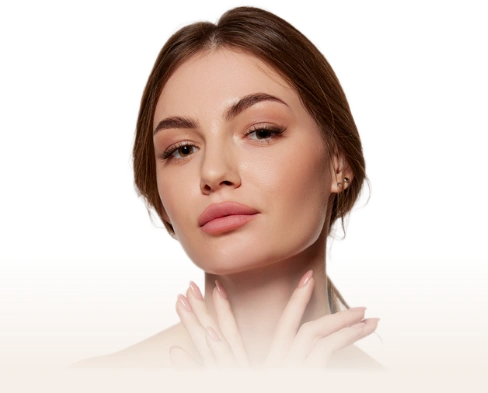Botox and Dysport are both injectable treatments made from botulinum toxin type A that temporarily relax muscles to smooth wrinkles and fine lines. Botox has been used longer and is FDA-approved for multiple areas, including forehead lines, crow’s feet, frown lines, bunny lines, and even medical issues like migraines or excessive sweating. Dysport is FDA-approved for glabellar lines (the “11” lines between the eyebrows) but is also used off-label for other facial areas.
The main difference lies in how they work: Dysport has smaller molecules that spread more easily and may show results within 2–3 days, while Botox typically takes 3–5 days and stays more localized. In terms of longevity, both last about 3–4 months, though some patients find Botox lasts slightly longer.
Cost varies depending on dosage and treatment area. Botox is usually priced per unit, while Dysport may require more units for the same area, though the final price often ends up being similar. Results are natural-looking with both, showing smoother skin and softer lines before gradually wearing off.
Recovery is minimal, most patients return to daily activities right after treatment, with only mild redness, swelling, or bruising possible. Side effects are generally temporary, though rare risks include drooping eyelids or asymmetry. Both treatments are considered safe for long-term use when administered by trained professionals.
Key Takeaways
Choose Botox if…
- You want precise treatment for small areas (like crow’s feet or fine lines).
- You prefer slightly longer-lasting results (typically 3–4 months).
- You’re looking for a product with the longest track record and wide FDA approvals.
Choose Dysport if…
- You’re treating larger areas (like the forehead or frown lines).
- You want to see results faster (sometimes within 2–3 days).
- You prefer a product that spreads more easily for softer, blended results.
What is Botox?
Botox is one of the most recognized names in medical aesthetics. First approved by the FDA in 1989 for medical use and in 2002 for cosmetic treatments, Botox has become the world’s most popular injectable for reducing wrinkles and fine lines. In fact, according to the American Society of Plastic Surgeons, more than 7 million Botox procedures were performed in the U.S. in 2022 alone.
Botox works by using a purified form of botulinum toxin type A. When injected into targeted facial muscles, it temporarily blocks the nerve signals that cause those muscles to contract. The result is smoother skin, softened wrinkles, and a refreshed, more youthful look without surgery or downtime.
Beyond cosmetics, Botox is also used in medicine to treat conditions like migraines, excessive sweating (hyperhidrosis), and muscle stiffness, making it a versatile treatment trusted by dermatologists and plastic surgeons worldwide.
Types of Botox
There are different types of Botox depending on the use:
- Botox Cosmetic: Designed for reducing wrinkles and fine lines in the face.
- Botox Therapeutic: Used for medical conditions like excessive sweating, migraines, or muscle spasms.
- Baby Botox: A gentler, diluted form of Botox that targets fine lines with a subtle, natural look while keeping facial movement.
What is Dysport?
Dysport is another leading injectable treatment in the botulinum toxin family. First approved by the FDA in 2009, it is widely used in both cosmetic and medical fields. Dysport is especially known for treating glabellar lines (the frown lines between your eyebrows) but can also be used in other areas of the face for a smoother, younger appearance.
Like Botox, Dysport works by using botulinum toxin type A to temporarily relax targeted muscles. By blocking the nerve signals that cause muscle contractions, it softens wrinkles and prevents new lines from forming.
One of Dysport’s unique features is that it has smaller molecules, which may allow it to spread more easily across a treated area. For patients, this can mean faster results and a natural-looking softening of wrinkles especially in larger treatment zones like the forehead.
Beyond cosmetic uses, Dysport is also FDA-approved to treat medical conditions such as cervical dystonia and muscle spasticity, making it a trusted option in both aesthetics and neurology.
Types of Dysport
- Standard Dysport: Dysport is typically offered in one standard injectable form. It contains Botulinum Toxin Type A and is mainly used for treating moderate to severe glabellar lines (the “11” lines between your eyebrows). However, many doctors also use it off-label to treat other areas like crow’s feet and forehead wrinkles.
- No Official Variants Like Botox: Dysport doesn’t have distinct cosmetic or therapeutic versions marketed separately like Botox does. Instead, the dosing and dilution can be adjusted by the provider depending on the treatment area and patient needs.
Comparison Chart
| Feature | Botox | Dysport |
| FDA Approval | 1989 (medical), 2002 (cosmetic) | 2009 (cosmetic + medical) |
| Primary Use | Treats a wide range of areas: frown lines, crow’s feet, forehead lines, bunny lines, chin dimpling, neck bands | Specifically FDA-approved for glabellar lines, but often used off-label for forehead and crow’s feet |
| How It Works | Botulinum toxin type A that blocks nerve signals to muscles, preventing contractions | Botulinum toxin type A, works the same way but has smaller molecules and spreads more easily |
| Onset of Results | 3–5 days (full results in ~7–14 days) | 2–4 days (sometimes faster full effect) |
| How Long It Lasts | Typically 3–4 months | Typically 2–4 months |
| Spread | More localized effect, ideal for precise areas like around the eyes | Diffuses more broadly, making it better for larger areas like the forehead |
| Units Required | Higher potency per unit (fewer units needed per area) | Lower potency per unit (requires more units, but often balances out in cost) |
| Cost (U.S. Average) | $10–20 per unit | $4–6 per unit (but needs more units per treatment area, so total cost is similar) |
| Best For | Patients needing precision (small areas, detailed wrinkle targeting) | Patients with larger treatment areas or wanting quicker results |
| Other Medical Uses | Migraines, excessive sweating, TMJ, overactive bladder, muscle stiffness | Cervical dystonia, spasticity, off-label similar uses as Botox |
| Side Effects | Mild swelling, bruising, temporary headaches, rare drooping eyelid | Same as Botox; drooping eyelid risk slightly higher due to spread |
| Longevity of Brand | Longest history, most studied, household name worldwide | Newer but well-established, strong clinical evidence, trusted alternative |
| Patient Preference | Often chosen for precision and brand trust | Often chosen for faster results and softer spread in larger areas |
What are the differences between Dysport and Botox?
What factors should I consider when choosing between Botox and Dysport for my treatment?
When deciding between Botox and Dysport, consider:
- Treatment Area – Smaller, detailed areas (eyes, mouth, brows) often do best with Botox. Larger areas (like forehead lines) may respond better to Dysport.
- Desired Speed – If you want results in just a couple of days, Dysport typically works faster.
- How Long Results Last for You – Some patients find Botox lasts longer, while others notice little difference.
- Budget – Per-unit costs differ, but the final price is usually similar.
- Provider’s Expertise – The skill of the injector is often more important than the brand itself.
- Personal Experience – Many patients try both and then stick with the one they prefer.
Which lasts longer, Dysport or Botox?
Both treatments are temporary, and understanding how long Botox and fillers last can help set realistic expectations. Botox tends to last around 3 to 4 months, while Dysport typically lasts 2 to 4 months. (Source: Drugs.com) Some patients find that Botox gives them a little more staying power, especially in smaller, targeted areas like crow’s feet or frown lines. Dysport, on the other hand, may wear off a bit sooner, but this varies from person to person. Factors like your metabolism, treatment area, and how active your facial muscles are can all influence how long the results last. Ultimately, both require repeat treatments a few times a year to maintain the effect.
How long does it take to see results from Dysport and Botox?
One of the key differences between the two treatments is how quickly results appear. Many people notice faster results with Dysport, sometimes within 2–4 days, compared to Botox which usually takes 4–7 days. That means if you’re looking for a quick fix before a big event, Dysport might be the better choice. Botox results are just as effective, but the onset is a little slower. In both cases, patients usually see their best results within two weeks of treatment.
How much do Dysport and Botox cost?
The cost of Dysport and Botox treatments can vary depending on your location, provider expertise, and the number of units required for your treatment area. Botox is priced per unit, typically ranging from $12 to $20 per unit in the U.S. Dysport, on the other hand, is often slightly less expensive per unit, with prices averaging around $4 to $6 per unit.
However, the key detail to remember is that Dysport requires more units to achieve results equivalent to Botox. For example, 1 unit of Botox is roughly equal to 3 units of Dysport.
Dysport looks much cheaper, but it usually requires more units to achieve the same results. The typical conversion is 2.5–3 units of Dysport for every 1 unit of Botox, meaning the overall cost often ends up being very similar between the two.
Is Dysport cheaper than Botox?
Not necessarily. While Dysport looks cheaper at first glance, once the unit conversion is taken into account, the overall cost for a treatment session is often comparable to Botox. Some patients may notice Dysport working out slightly more cost-effective in larger treatment areas (like the forehead), while Botox may be more predictable in smaller, highly targeted areas (like crow’s feet).
Ultimately, the total price depends on the area treated, your goals, and your provider’s pricing model.
When to use Botox or Dysport?
Choosing between Botox and Dysport often depends on your treatment goals, the area being treated, and how your body responds to the product. Both are FDA-approved neurotoxins that smooth wrinkles and relax overactive muscles, but there are situations where one may be more suitable than the other.
Botox may be better if:
- You’re targeting small, precise areas like crow’s feet or fine lines around the mouth.
- You want slightly longer-lasting results (typically 3–4 months).
- You prefer a slower onset that allows results to appear more gradually and subtly.
Dysport may be better if:
- You want to treat larger areas such as the forehead, since it spreads more easily.
- You’re looking for faster results, with some patients seeing improvement in 2–3 days.
- You prefer a softer, more natural look in broader areas rather than very sharp precision.
What results can you expect before and after Dysport or Botox?
With Dysport or Botox, you can expect your wrinkles and fine lines to soften noticeably within a few days of treatment. The skin looks smoother, the face appears more relaxed, and the overall effect is a younger, refreshed look. Results typically continue to improve for up to two weeks and last for several months before a touch-up is needed.
What is the recovery time for Dysport and Botox?
Recovery time for both Dysport and Botox is minimal. Most patients can return to their normal activities immediately after treatment, with only mild redness or swelling at the injection site that usually resolves within a few hours. There’s no need for downtime, making these treatments easy to fit into a busy schedule.
Results last 3 to 4 months for Botox and 2 to 4 months for Dysport, depending on the individual and the area treated. To maintain a consistently smooth, youthful look, most patients schedule treatments about 3 times per year.
Aftercare Tips for Botox and Dysport
To get the best results and avoid complications, follow these simple aftercare steps:
- Stay upright for at least 4 hours after treatment.
- Avoid rubbing or massaging the treated areas.
- Skip strenuous exercise, alcohol, and blood-thinning medications (like aspirin) for 24 hours.
- Use a gentle skincare routine and avoid facials or chemical peels for a few days.
Who Should Avoid Treatment?
Botox and Dysport are generally safe, but some patients should defer treatment, including:
- Women who are pregnant or breastfeeding.
- Individuals with neuromuscular disorders (such as myasthenia gravis).
- Anyone with known allergies to botulinum toxin or treatment ingredients.
- Patients with active skin infections at the injection site.
What should you avoid after Dysport or Botox?
After your treatment, there are a few simple precautions that help ensure the best results and reduce the risk of side effects:
- Avoid rubbing or massaging the treated area for at least 24 hours — this prevents the product from spreading to unintended muscles.
- Skip strenuous exercise, saunas, and hot tubs for the first 24 hours, since heat and increased blood flow can reduce effectiveness.
- Stay upright for at least 4 hours after injections — don’t lie down or bend excessively.
- Avoid alcohol and blood-thinning medications (like aspirin or ibuprofen) for a day, as they can increase bruising.
By following these simple steps, you help your Dysport or Botox settle properly so you can enjoy smoother, longer-lasting results.
What are the possible side effects of Dysport and Botox?
Many patients also have concerns shaped by common Botox myths, but most side effects are mild and temporary when treatment is performed by professionals.
Common (mild, short-lived):
- Redness or swelling at the injection site
- Small bruises
- Mild headache
- Temporary soreness
Less common:
- Drooping eyelid (ptosis)
- Uneven smile or facial asymmetry
- Flu-like symptoms
Rare:
- Allergic reaction
- Difficulty swallowing or breathing (very rare, requires urgent medical attention)
Can Dysport cause a permanent drooping eyelid?
No, Dysport does not cause permanent drooping of the eyelid.
If drooping (called ptosis) happens, it’s usually because the product spreads to a nearby muscle. This side effect is rare, temporary, and typically resolves within a few weeks as the neurotoxin wears off. Choosing an experienced injector greatly reduces the risk.
How safe are Dysport and Botox in the long term?
Both Dysport and Botox are considered safe for long-term use when administered by qualified professionals.
Studies spanning over 20 years show no evidence of cumulative harm, and many patients receive regular treatments for years without complications. The effects are temporary, so once the product wears off, muscle activity returns to normal. The key to long-term safety is proper dosing, correct injection technique, and medical supervision.
Who is a good candidate for Dysport or Botox?
| Criteria | Botox | Dysport |
| Age Range | Typically 25–65 years | Typically 25–65 years |
| Primary Concerns | Forehead lines, crow’s feet, frown lines, bunny lines, neck bands, excessive sweating, migraines, TMJ issues | Moderate-to-severe glabellar lines, crow’s feet, forehead wrinkles, spasticity, cervical dystonia |
| FDA Approval | Cosmetic since 2002; multiple therapeutic uses since 1989 | Cosmetic approval since 2009; therapeutic uses earlier (spasticity, cervical dystonia) |
| Onset of Results | 3–7 days | 2–4 days (faster onset in many cases) |
| Duration of Results | 3–4 months | 2–4 months |
| Spread of Effect | More localized, stays closer to injection site | Spreads slightly more, better for larger treatment areas |
| Skin Type Suitability | Works well for most skin types | May show slightly better diffusion in thicker or oilier skin |
| Muscle Activity | Best for small, precise muscle groups | Better for broader or stronger muscle areas |
| Desired Look | Ideal for patients wanting very precise, controlled outcomes | Ideal for patients wanting natural, softer diffusion of wrinkles |
| Treatment Frequency | Every 3–4 months | Every 3–4 months (sometimes slightly sooner) |
| Medical Candidates | Patients with migraines, hyperhidrosis, TMJ, muscle spasticity | Patients with cervical dystonia, limb spasticity, or cosmetic wrinkle concerns |
| Not Suitable For | Pregnant or breastfeeding women, those with neuromuscular disorders, severe allergies to botulinum toxin ingredients | Same restrictions as Botox |
Are there specific skin types that respond better?
Yes, both Dysport and Botox work well across all skin types, but Dysport may diffuse slightly better in patients with thicker or oilier skin, while Botox offers more precision for thinner or more delicate skin areas. Ultimately, results depend more on muscle activity and injection technique than skin type itself.
What is the treatment procedure like, and does it hurt?
The treatment procedure for both Dysport and Botox is quick, straightforward, and minimally invasive.
A trained provider begins by cleansing the treatment area and sometimes applying a numbing cream or ice pack to reduce discomfort. Using a very fine needle, the neurotoxin is injected directly into specific facial muscles. The entire process usually takes 10–20 minutes, depending on how many areas are being treated.
Most patients describe the feeling as a tiny pinch or slight stinging sensation that lasts only a few seconds. Any mild redness or swelling at the injection site typically resolves within a few hours.
Still on the fence between Dysport and Botox? Skip the guesswork, our 60-second Treatment Planner helps you discover which neurotoxin (or alternative) is best suited to your goals, concerns, and facial dynamics. Simply select your key priorities—fine lines, frown lines, natural movement—and receive a personalized, clinician-reviewed recommendation to discuss during your consult.
How many units of Dysport and Botox are needed per treatment area?
| Treatment Area | Botox (Units) | Dysport (Units) |
| Glabellar Lines (frown lines between eyebrows) | 20 | 50–60 |
| Forehead Lines | 10–20 | 30–60 |
| Crow’s Feet (around eyes) | 12–24 (6–12 per side) | 30–60 (15–30 per side) |
| Bunny Lines (nose wrinkles) | 5–10 | 15–30 |
| Eyebrow Lift | 2–5 per side | 10–15 per side |
| Chin (dimpling/cobblestone) | 6–10 | 15–30 |
| Jawline / Masseter (slimming) | 25–50 per side | 60–120 per side |
| Neck Bands (platysmal bands) | 25–50 total | 75–150 total |
| Lip Flip (upper lip) | 4–8 | 10–20 |
| Gummy Smile | 2–4 | 10–15 |
| Underarms (excess sweating / hyperhidrosis) | 50 per side | 150 per side |
| Hands (excess sweating) | 50–60 per hand | 150–180 per hand |
| Migraines (FDA approved) | ~155 (spread across multiple points) | ~300–400 (off-label, provider dependent) |
Dysport units are roughly 2.5–3 times the number of Botox units, because Dysport is less concentrated.
Always consult a licensed injector, as they will tailor dosing to your muscle strength, facial anatomy, and desired results.
Which areas can Botox and Dysport treat?

Both Botox and Dysport are versatile treatments that can target cosmetic wrinkles and certain medical concerns. Here’s a clear breakdown:
Treatment Areas
- Forehead lines (horizontal wrinkles)
- Glabellar lines (frown lines between eyebrows)
- Crow’s feet (lines at the outer corners of the eyes)
- Bunny lines (wrinkles across the nose)
- Eyebrow lift (subtle arch/refresh)
- Chin dimpling (“cobblestone” or “orange peel” chin)
- Jawline / Masseter muscle (face slimming, teeth grinding relief)
- Neck bands (platysmal bands causing neck wrinkles)
- Lip flip (softening a gummy smile or enhancing lip shape)
- Lines around the mouth (smoker’s lines, marionette lines)
Medical Conditions
- Chronic migraines (FDA approved for Botox)
- Excessive sweating (hyperhidrosis) — underarms, hands, feet
- Muscle spasms / dystonia (neck, limbs)
- Overactive bladder (Botox FDA approved)
- Eye muscle disorders (strabismus, blepharospasm)
Pros and Cons of Botox
Pros
- Proven & Widely Used: FDA-approved since 2002 for cosmetic use, with decades of safety data.
- Versatile Applications: Treats multiple facial areas (forehead, crow’s feet, frown lines, chin, neck) and medical conditions (migraines, sweating, muscle spasms, overactive bladder).
- Precise Results: Great for smaller, delicate areas where control is key.
- Long-Lasting Effects: Results typically last 3–4 months, sometimes longer with regular treatments.
- Natural Look (when done correctly): Can soften wrinkles without looking “frozen.”
Cons
- Slower Onset: Takes about 5–7 days to see visible effects (vs. Dysport’s faster onset).
- Higher Cost per Unit: Botox is usually more expensive per unit compared to Dysport.
- Maintenance Required: Needs repeat treatments every few months to maintain results.
- Risk of Side Effects: Temporary bruising, swelling, headache, or drooping if injected improperly.
- Not Immediate for Everyone: Some patients may need touch-ups to reach optimal results.
Pros and Cons of Dysport
Pros
- Faster Onset: Results can appear in as little as 2–3 days (quicker than Botox).
- Better for Larger Areas: The formula spreads more easily, making it effective for treating broad regions like the forehead.
- Natural, Softer Look: Because of its diffusion, Dysport can create smoother, less “stiff” results.
- Slightly Lower Cost: Often priced cheaper per unit than Botox, making it appealing for budget-conscious patients.
- FDA-Approved & Safe: Approved for cosmetic use (glabellar lines) and multiple therapeutic conditions.
Cons
- Less Precise: The spreading effect can sometimes affect nearby muscles if not administered carefully.
- Slightly Shorter Duration: Results usually last 2–4 months, which may be less than Botox for some patients.
- Limited FDA Indications: Officially approved only for glabellar lines (though often used off-label for other areas).
- Unit Conversion Confusion: Dysport requires more units than Botox per treatment, which can confuse patients about pricing.
- Risk of Side Effects: Similar to Botox—temporary swelling, bruising, or drooping eyelid if injected incorrectly.
Can Dysport and Botox be combined with other treatments?
Yes, Dysport and Botox can be safely combined with other treatments such as dermal fillers, microneedling, chemical peels, and laser resurfacing to enhance overall results, as long as they are timed and planned by a qualified provider.
What are the benefits of using Dysport for wrinkle treatment, and how does it compare to Botox?
Dysport offers several benefits for wrinkle treatment, particularly for patients seeking faster results and a more natural look. Because of its smaller molecular size, Dysport tends to spread more easily after injection, which makes it especially effective for treating larger areas like the forehead with fewer injection points. Patients often notice results within 2–3 days, which is slightly quicker than Botox.
When compared to Botox, Dysport may provide a softer, more blended effect, while Botox offers more precision and control in smaller, targeted areas such as crow’s feet or frown lines. Both deliver temporary wrinkle reduction, but Dysport is often chosen when a broader smoothing effect is desired, whereas Botox is preferred for highly localized treatments.
Both Dysport and Botox are used in both cosmetic and medical settings, with overlapping but slightly different applications:
What are the clinical uses of Dysport and Botox?
Cosmetic Uses
- Wrinkle Reduction: Forehead lines, frown lines (glabellar), crow’s feet, bunny lines, chin dimpling, neck bands.
- Facial Slimming: Treating enlarged masseter muscles to slim the jawline.
- Eyebrow Lift: Subtle lifting effect for a refreshed look.
Medical Uses
- Chronic Migraines: Botox is FDA-approved for migraine prevention.
- Hyperhidrosis (Excessive Sweating): Both can be used for underarms, palms, or soles.
- Muscle Spasticity: Treats stiffness in arms, legs, and neck (both Dysport and Botox are FDA-approved).
- Cervical Dystonia: Both approved, Dysport originally entered the U.S. market for this condition.
- Eye Conditions: Botox is used for strabismus (crossed eyes) and blepharospasm (uncontrollable blinking).
- TMJ / Jaw Clenching: Reduces pain and muscle overuse.
Why do some people prefer Dysport over Botox?
Some people prefer Dysport over Botox because it tends to work faster, can cover larger areas with fewer injections, and may look more natural on dynamic facial expressions due to its wider spread.
What should you do before getting Dysport or Botox?
Before getting Dysport or Botox, it’s important to prepare properly to ensure safe treatment and optimal results:
- Avoid blood thinners (aspirin, ibuprofen, fish oil, vitamin E, alcohol) for at least 24–48 hours to reduce bruising.
- Pause certain supplements like ginkgo biloba, garlic, or St. John’s Wort if possible, as they can increase bleeding risk.
- Stay healthy — reschedule if you’re sick, have an infection near the injection site, or are on antibiotics.
- Remove makeup before the procedure so the skin is clean and sterile.
- Discuss medical history with your provider, including pregnancy, breastfeeding, neuromuscular conditions, or prior reactions to injectables.
- Set realistic expectations about results and maintenance, as effects are temporary and require repeat sessions.
How can you find a qualified professional for Dysport or Botox treatments in Manhattan, NYC?
Both Botox and Dysport are widely available at top aesthetic clinics in Manhattan, NYC. Choosing a local provider ensures you get access to highly experienced injectors who work with a diverse patient base and understand the aesthetic preferences common in New York. Whether you’re seeking subtle enhancements or more noticeable wrinkle reduction, you can find board-certified dermatologists and aesthetic specialists right here in Manhattan to deliver safe, effective results.
What is better for wrinkles: Botox, Dysport, or Xeomin?
When it comes to treating wrinkles, Botox, Dysport, and Xeomin are all effective, but each has unique advantages:
- Botox – The most well-known and widely used option. It’s versatile, FDA-approved for multiple areas (forehead, crow’s feet, frown lines), and delivers consistent, reliable results. Best for patients who want a trusted, time-tested treatment.
- Dysport – Works faster in some cases (results may appear in 2–3 days vs. Botox’s 5–7 days) and spreads more easily, making it especially effective for larger areas like the forehead. Best for patients seeking quicker results or broader coverage.
- Xeomin – Known as the “naked injectable” because it doesn’t contain accessory proteins. This means there’s less risk of developing resistance over time. Best for patients who want a more purified formula or who’ve stopped responding to Botox or Dysport.

About The Author
Dr. Syra Hanif M.D.
Board Certified Primary Care Physician
Dr. Hanif is the Director of Aesthetic Medicine. She is a board-certified physician in Aesthetic Medicine who specializes in using non-surgical alternatives in order to enhance one's appearance through Botox and fillers.
Read More











